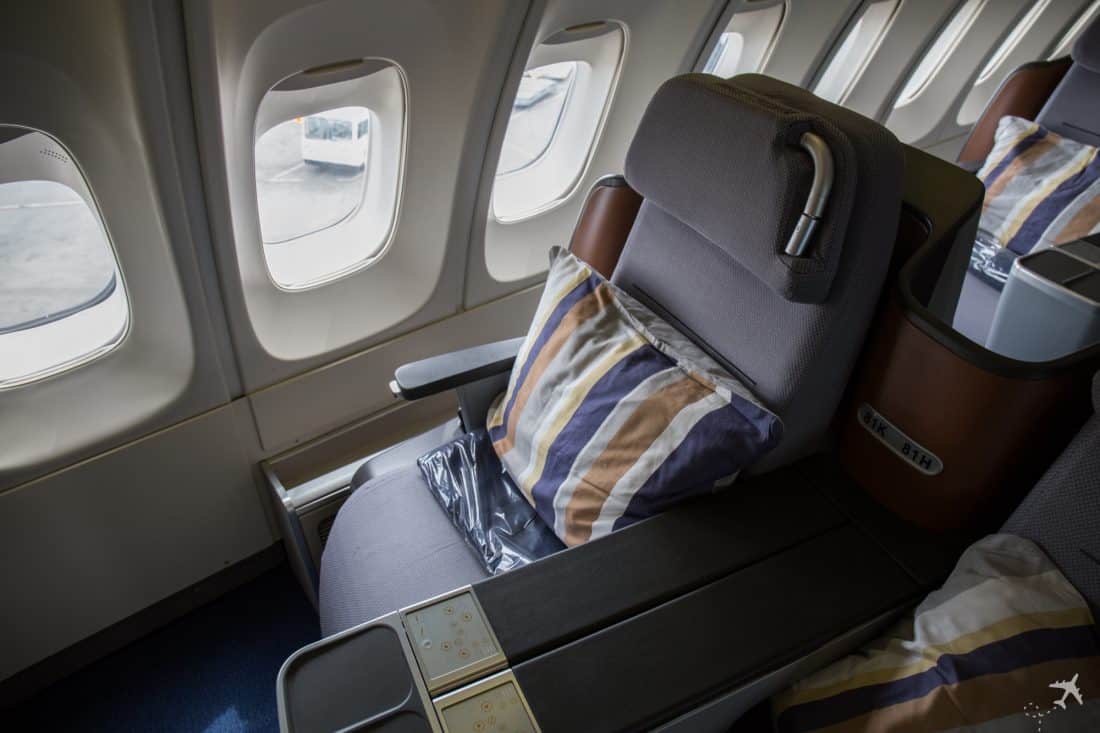Flights to Japan have never been particularly cheap. But they are currently even more expensive than they were before the pandemic. In economy class, there is hardly a ticket for under €800, in business class €2,500 and up can be expected from most airports in Europe.
It is cheaper – as so often – when departing from Budapest. If two layovers don’t put you off, you can get business class tickets to Tokyo for HUF 567,200 (~€1,467). Flights are mostly with Lufthansa and Austrian, and availability is (rather limited) from January to September 2023.
The Flex fare is also fascinating, with prices starting at HUF 644,900 (~€1,668). You can then cancel this ticket free of charge at any time before departure. All that remains is an exchange rate risk due to the fluctuating rate of the Hungarian forint.
Entry into Japan: Entry into Japan is now permitted again without a visa. Either proof of vaccination including a booster or a negative corona test 72 hours before departure is required. A health form (MySOS or Visit Japan Web) must also be filled out.
Entry into South Korea: Entry into Korea is also possible again. If you want to enter Korea, a K-ETA is required for ₩10,200 (~€6).
Rebooking regulations: The Business Basic fare requires a fee for rebooking amounting to €250 plus the price difference. Since recently, a change of destination or departure airport is no longer permitted. If anything is unclear, we recommend the Flex fare. You can cancel that one free of charge at any time before departure.
Unfortunately, booking these flights is quite complicated. A simple search on Lufthansa.com is not enough, you have to use a multi-stop search. More on this in the Search & Book section.
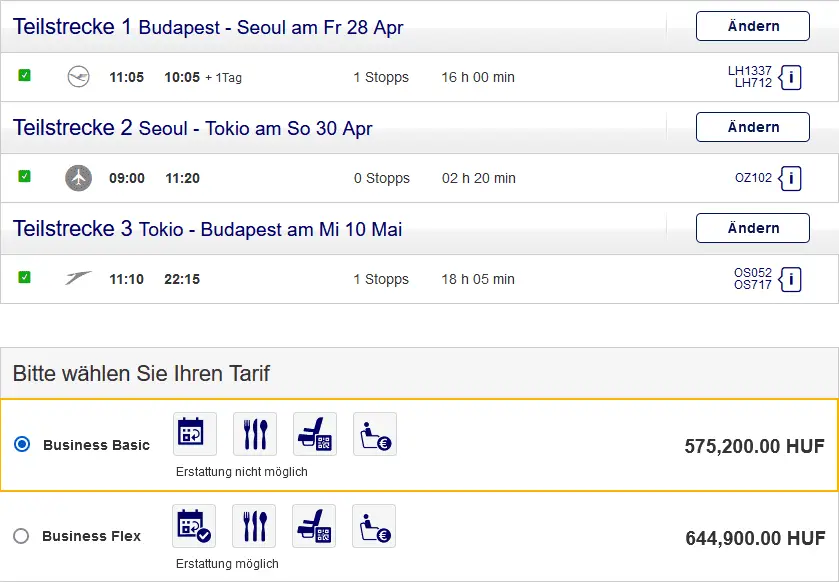
There are two layovers on the way there, mostly in Frankfurt and Seoul. In that case, you’ll spend the long-haul flight sitting in a Lufthansa Boeing 747-400. Asiana will fly you from Seoul to Tokyo. On the way back, an Austrian Boeing 777 usually flies directly to Vienna. There are probably other options as well, but Vienna was the most common.
There’s still one catch: With the tickets for €1,390, you often have a 22-hour overnight stay in Seoul. It’s nice to discover South Korea for a day, but not for people who want to fly to Japan as quickly as possible. There are also connections without an overnight stop – but then usually only the Flex fare is available for €1,560.
Search & Book
How long the offer is still valid is not stated in the fare rules. However, the availability of the cheapest booking class is already very thin, and it is unlikely to get any better in the future. We were able to find cheap tickets for travel from January to September 2023. There’s probably something for October too, but the Matrix won’t display it.
The minimum stay requirement is 3 days or one night from Saturday to Sunday, and there is no upper stay limit. Stopovers (> 24h) in Seoul are permitted according to the fare rules for a surcharge of €150.
Find Flights with the Matrix
The best way to search for connections is to use the ITA Matrix (instructions). In order for the flights to be found, you have to use a few routing codes or extension codes. I used the following:
- Routing Codes: Restriction to outbound flight via Seoul + return flight with only one stopover in Vienna, Zurich, …
- Extension Codes: Restriction to Star Alliance flights + possibly maximum travel time with
maxdur hh:mm
This is necessary because the calculation time of the matrix is limited. If there are too many options, the options via Seoul are often not displayed at all.
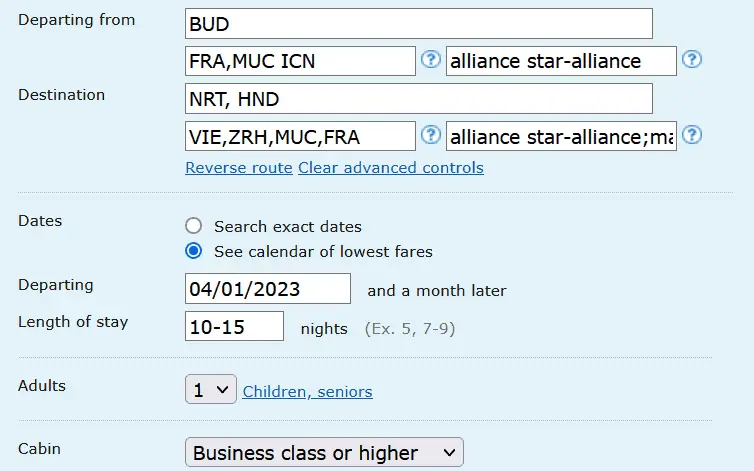
You can then use the flexible calendar search to find dates within a month. These are then displayed to you in the monthly view:
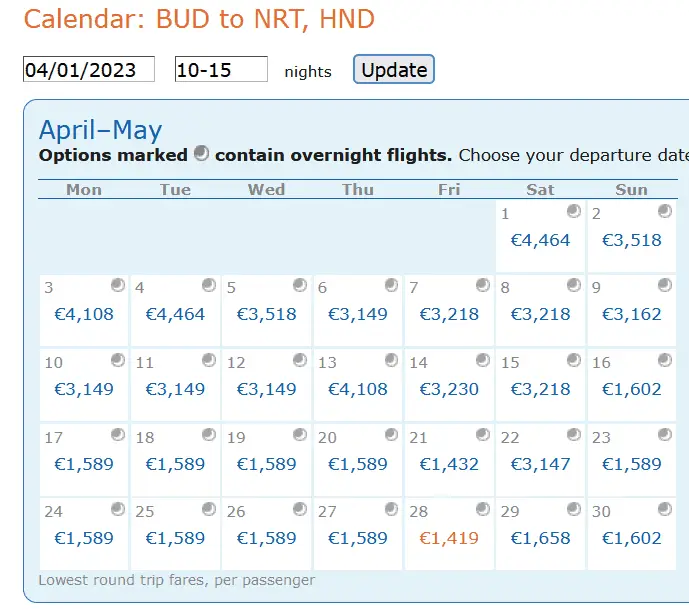
If you can only find tickets here for €1,589, don’t let that put you off. That is usually the Flex fare, while booking flights for around €1,400 in Business Basic (without a cancellation option) is also possible.
Now all you have to do is choose a connection. It is best to pay attention to the duration column here, so that you don’t have 7 hours to change planes in Frankfurt, for example, but “only” 3:

With a click on the connection, you can expand the details and see the flight numbers.
Book on Lufthansa.com
As soon as you have found your desired connection, you can start booking. Unfortunately, the ITA Powertools for forwarding Matrix → Lufthansa.com do not work. And a search directly on lufthansa.com usually does not spit out the options via Seoul.
You must therefore manually start a multi-stop search. You have 2 options for this:
- You use our booking form above and only adjust the travel dates there. This is the most convenient option and at the same time, we receive a few euros commission for completed bookings. Thanks for that.
- You use the multistop search form on Lufthansa.com. There you have to enter three individual segments. However, the form is very sluggish, especially when entering airport codes.
It is important that you enter three segments individually: Budapest – Seoul, Seoul – Tokyo and Tokyo – Budapest. Pay attention to the time difference, or take over the travel dates from the matrix. Depending on the connection, the Seoul – Tokyo flight takes place one or two days after the long-haul flight.
Now comes the most important step. For all three flights, you must select exactly the segments that the matrix shows you. You should pay attention to either the flight number or the times here in order to choose the right flights. One wrong click and the ticket suddenly costs three times as much.
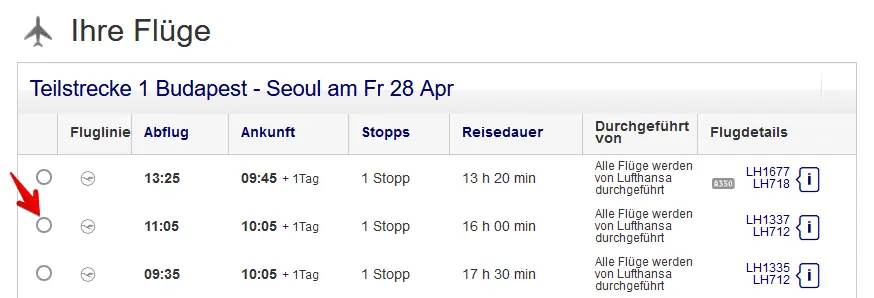
After all three routes have been selected, click on Save selection. Now there are two possible outcomes:
- Option #1: You see prices between HUF 570,000 and 650,000 → All right, you can proceed with the booking
- Option #2: Prices now jump to HUF 1,000,000 or more. In this case, the availability query of the matrix is obviously not correct. This is rare, but unfortunately, you’ll have to start over in this case.
Mileage
The tickets are issued in booking class P, the Asiana segment is in class D. The following mileage credits await you for the example above:
- 20,315 Miles on Air China PhoenixMiles
- 15,535 Miles on Singapore KrisFlyer
- 14,893 Miles on ITA Volare
- 12,623 Miles on Copa ConnectMiles
- 12,623 Miles on Thai Royal Orchid Plus
- 12,623 Award Miles + 2,494 PQP on United MileagePlus
- 12,298 Miles on Air Canada Aeroplan
- 12,298 Points + 2,460 SQC on Air Canada Aeroplan 2026
- 11,647 Award Miles on LATAM Pass
- 9,130 Miles on ANA Mileage Club
- 7,464 Miles on Turkish Airlines Miles&Smiles
- 7,414 Miles on Aegean Miles+Bonus
- 7,164 Miles on Asiana Club
- 6,797 Award Miles + 3,399 Tier Miles on Avianca LifeMiles
- 6,797 Miles on EVA Infinity MileageLands
- 6,797 Miles on Egyptair Plus
- 5,080 Award Miles + 520 Points on Miles&More
- 976 Miles on Ethiopian ShebaMiles
- 976 Miles on TAP Miles&Go
- 976 Award Miles on Etihad Guest
- 518 AsiaMiles on Asia Miles
- Customize Calculation
Destination
Hotel prices in Tokyo usually start at roughly €35-55, depending on the hotel category and specific dates. Whichever category and hotel you opt for, make sure to get the best price! Our recommendation is to search on booking.com, or even on our own Travel-Dealz hotel search:
Information & Tips for Tokyo
Tokyo is known for its blend of traditional and modern attractions, including the historic Senso-ji Temple, the bustling Shibuya Crossing, and the futuristic Odaiba district. The currency used is the Japanese yen (JPY), and credit cards are widely accepted in many places. Tokyo can be expensive, especially for accommodation and dining in tourist areas, but budget options are available. The weather varies: summers are hot and humid, while winters are cold but generally dry. The best times to visit are in spring (for cherry blossoms) and autumn (for mild temperatures).
We’ve compared various esim providers, such as YohoMobile and Nomad. To see which plan is best for your travel needs and which network offers the best coverage, feel free to read our detailed guide:
The Best eSIM Plans for Japan 🇯🇵 Compared
→ All Dealz for Tokyo
Information & Tips for Japan
Japan offers a blend of modern cities and natural beauty, with highlights including Tokyo’s bustling urban landscape, Kyoto’s historic temples, Mount Fuji, and the hot springs of Hakone. The currency is the Japanese yen (JPY), and credit cards are widely accepted in urban areas, though cash is still common in rural regions. Japan can be pricey, especially in cities, with high costs for accommodation and dining, but budget options are available. The weather varies by region: summers are hot and humid, while winters can be cold, particularly in the north. The best time to visit is typically during spring (for cherry blossoms) or autumn (for fall foliage).
Japan’s transport infrastructure is highly efficient and easy to navigate. In cities like Tokyo and Osaka, the metro and train systems are extensive, punctual, and relatively easy to use, though they can get crowded during peak hours. Buses and taxis are also available, but less convenient for tourists. For intercity travel, Japan’s Shinkansen (bullet trains) are fast, comfortable, and reliable, though more expensive than other options. Buses and domestic flights are also available for longer distances, but trains remain the preferred choice for many travellers due to speed and convenience.
We’ve compared various esim providers, such as YohoMobile and Nomad. To see which plan is best for your travel needs and which network offers the best coverage, feel free to read our detailed guide:
The Best eSIM Plans for Japan 🇯🇵 Compared
→ All Dealz for Japan
